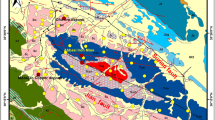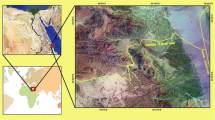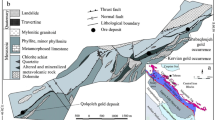Abstract
The world’s increasing demand for rare earth elements (REEs) highlights the potential for using new multispectral remote sensing techniques to define new exploration targets in arid regions, such as the Kingdom of Saudi Arabia (KSA), Egypt, and regions of central and western China. Although REEs cannot be detected by satellite multispectral instruments, REEs-bearing alkaline granites can be identified on ASTER imagery. Herein, we develop a new ASTER band ratio scheme to delineate mineralization-related features of the Ghurayyah REE-bearing peralkaline granite in the northwestern KSA. The Ghurayyah peralkaline stock is located at the intersection of a NW striking segment of the Najd-fault system, and an E-W striking fault. It is surrounded to the north and west by metavolcanics, from east by the Jabal Dabbagh alkali granite, and from the south by monzogranite. The mineralogical composition of granitic rocks resulted in spectral variation and causes absorption features at different wavelengths in the shortwave infrared (SWIR). The newly developed band ratios were constructed from (b6 + b8)/(b6 − b8) in red; (b6 + b8)/b4 in green, and (b7 − b9)/(b7 + b9) in blue, enabling the discrimination between the Ghurayyah REE-bearing peralkaline granite, Jabal Dabbagh alkali granite, monzogranite, and metavolcanics. Future work will be carried out to perform higher-resolution drone-based hyperspectral imaging for new high-resolution mapping and evaluate the existing REE deposits, emphasizing field spectral measurements to identify the spectral reflectance of REEs mineralized zones and the absorption features of monazite, columbite-tantalite, and aeschynite- (Y), coupled with rock sampling for petrographical, spectral, and geochemical analyses. These methods have great potential for locating REEs-bearing peralkaline granites in the Arabian shield and elsewhere, such as arid portions of central and western China and adjacent regions.
Similar content being viewed by others
References Cited
Amer, R., Kusky, T. M., Ghulam, A., 2010. Lithological Mapping in the Central Eastern Desert of Egypt Using ASTER Data. Journal of African Earth Sciences, 56(2/3):75–82. https://doi.org/10.1016/j.jafrearsci.2009.06.004
Amer, R., Kusky, T. M., El Mezayen, A., 2012. Remote Sensing Detection of Gold Related Alteration Zones in Um Rus Area, Central Eastern Desert of Egypt. Advances in Space Research, 49(1):121–134. https://doi.org/10.1016/j.asr.2011.09.024
Amer, R., El Mezayen, A., Hasanein, M., 2016. ASTER Spectral Analysis for Alteration Minerals Associated with Gold Mineralization. Ore Geology Reviews, 75:239–251. https://doi.org/10.1016/j.oregeorev.2015.12.008
Amer, R., El-Desoky, H., 2017. A Remote Sensing Method for Mapping Sillimanite Mineralization. Journal of African Earth Sciences, 134:373–382. https://doi.org/10.1016/j.jafrearsci.2017.07.008
Aseri, A. A., 2020. Rare-metal Alkaline Granite from the Arabian Shield, Saudi Arabia: [Dissertation]. The University of Western Ontario London, Ontario
Atwood, D. A., 2012. The Rare Earth Elements: Fundamentals and Applications. Chichester, West Sussex, United Kingdom. John Wiley & Sons, Hoboken
Brown, G., Schmidt, D., Huffman, A., 1983. Compiled Geological map of the Kingdom of Saudi Arabia 1963 to 1983. The Ministry of Petroleum and Mineral Resources, Kingdom of Saudi Arabia
Clark, R. N., Swayze, G. A., Wise, R., et al., 2007. USGS Digital Spectral Library Splib06a. U.S. Geological Survey, Reston
Drysdall, A. R., Jackson, N. J., Ramsay, C. R., et al., 1984. Rare Element Mineralization Related to Precambrian Alkali Granites in the Arabian Shield. Economic Geology, 79(6):1366–1377. https://doi.org/10.2113/gsecongeo.79.6.1366
Drysdall, A. R., Douch, C. J., 1986. NBTHZR Mineralization in Microgranite—Microsyenite at Jabal Tawlah, Midyan Region, Kingdom of Saudi Arabia. Journal of African Earth Sciences, 4:275–288. https://doi.org/10.1016/s0899-5362(86)80089-6
Elliott, J. E., 1983. Peralkaline and Peraluminous Granites and Related Mineral Deposits of the Arabian Shield, Kingdom of Saudi Arabia. U. S. Geological Survey Open-File Report 83–389
Elliott, J. E., Al-Yazidi, S., Al-Eissa, A., et al., 2001. Exploration of the Ghurayyah Radioactive Granite, Kingdom of Saudi Arabia, Saudi Geological Survey, Open-File Report, SGS-OF-2001-7
Fan, H. R., Yang, K. F., Hu, F. F., et al., 2016. The Giant Bayan Obo REE−Nb−Fe Deposit, China: Controversy and Ore Genesis. Geoscience Frontiers, 7(3):335–344. https://doi.org/10.1016/j.gsf.2015.11.005
Gabr, S., Ghulam, A., Kusky, T. M., 2010. Detecting Areas of High-Potential Gold Mineralization Using ASTER Data. Ore Geology Reviews, 38(1/2):59–69. https://doi.org/10.1016/j.oregeorev.2010.05.007
Gad, S., Kusky, T. M., 2007. ASTER Spectral Ratioing for Lithological Mapping in the Arabian-Nubian Shield, the Neoproterozoic Wadi Kid Area, Sinai, Egypt. Gondwana Research, 11(3):326–335. https://doi.org/10.1016/j.gr.2006.02.010
Goetz, A. F. H., Strivastava, V., 1985. Mineralogical Mapping in the Cuprite Mining District. In: Proceedings of the Airborne Imaging Spectrometer (AIS) Data Analysis Workshop. Jet Propulsion Laboratory Publication, Pasadena
Grasso, V. B., 2011. Rare Earth Elements in National Defense: Background, Oversight Issues, and Options for Congress. Congressional Research Service 7–5700. https://sgp.fas.org/crs/natsec/r41744.pdf
Greenwood, W. R., Hadley, D. G., Anderson, R. E., et al., 1976. Late Proterozoic Cratonization in Southwestern Saudi Arabia. Philosophical Transactions of the Royal Society of London Series A, Mathematical and Physical Sciences (1934-1990), 280(1298):517–527. https://doi.org/10.1098/rsta.1976.0010
Harris, N. B. W., Marriner, G. F., 1980. Geochemistry and Petrogenesis of a Peralkaline Granite Complex from the Midian Mountains, Saudi Arabia. Lithos, 13(4):325–337. https://doi.org/10.1016/0024-4937(80)90052-3
Johnson, P. R., 2006. Explanatory Notes to the Map of Proterozoic Geology of Western Saudi Arabia. Technical Report, Saudi Geological Survey, Jeddah. https://faculty.ksu.edu.sa/sites/default/files/Explanatory%20notes%20for;%20the%20shield%20sgs-tr-2006-4.pdf
Kruse, F. A., Lefkoff, A. B., Boardman, J. W., et al., 1993. The Spectral Image Processing System (SIPS) —Interactive Visualization and Analysis of Imaging Spectrometer Data. Remote Sensing of Environment, 44(2/3):145–163. https://doi.org/10.1016/0034-4257(93)90013-n
Kusky, T. M., Matsah, M. I., 2003. Neoproterozoic Dextral Faulting on the Najd Fault System, Saudi Arabia, Preceded Sinistral Faulting and Escape Tectonics Related to Closure of the Mozambique Ocean. Geological Society, London, Special Publications, 206(1):327–361. https://doi.org/10.1144/gsl.sp.2003.206.01.16
Kusky, T. M., Ramadan, T. M., 2002. Structural Controls on Neoproterozoic Mineralization in the South Eastern Desert, Egypt: An Integrated Field, Landsat TM, and SIR-C/X SAR Approach. Journal of African Earth Sciences, 35(1):107–121. https://doi.org/10.1016/s0899-5362(02)00029-5
Küster, D., 2009. Granitoid-Hosted Ta Mineralization in the Arabian-Nubian Shield: Ore Deposit Types, Tectono-Metallogenetic Setting and Petrogenetic Framework. Ore Geology Reviews, 35(1):68–86. https://doi.org/10.1016/j.oregeorev.2008.09.008
Laben, C. A., Brower, B. V., 2000. Process for Enhancing the Spatial Resolution of Multispectral Imagery Using Pan-Sharpening. United States Patent, 6(11):875
Lalande, P. G., 1977. Final Report on Preliminary Geological and Geophysical Investigation of the Ghurayyah Radioactive Granite, Kingdom of Saudi Arabia. Saudi Arabian Directorate General of Mineral Resources, Open-File Report DGMR-605
Ling, M. X., Liu, Y. L., Williams, I. S., et al., 2013. Formation of the World’s Largest REE Deposit through Protracted Fluxing of Carbonatite by Subduction-Derived Fluids. Scientific Reports, 3:1776. https://doi.org/10.1038/srep01776
Mars, J., Rowan, L., 2006. Regional Mapping of Phyllic- and Argillic-Altered Rocks in the Zagros Magmatic Arc, Iran, Using Advanced Spaceborne Thermal Emission and Reflection Radiometer (ASTER) Data and Logical OperatorAlgorithms. Geosphere, 2:161–186. https://doi.org/10.1130/ges00044.1
Melcher, F., Graupner, T., Gäbler, H. E., et al., 2017. Mineralogical and Chemical Evolution of Tantalum- (Niobium-Tin) Mineralisation in Pegmatites and Granites. Part 2: Worldwide Examples (Excluding Africa) and an Overview of Global Metallogenetic Patterns. Ore Geology Reviews, 89:946–987. https://doi.org/10.1016/j.oregeorev.2016.03.014
Ninomiya, Y., 2003. A Stabilized Vegetation Index and Several Mineralogic Indices Defined for ASTER VNIR and SWIR Data. In: IGARSS 2003 IEEE International Geoscience and Remote Sensing Symposium. Proceedings. July 21–25, 2003, Toulouse. https://doi.org/10.1109/igarss.2003.1294172
Perry, S. L., 2004. Spaceborne and Airborne Remote Sensing Systems for Mineral Exploration-Case Histories Using Infrared Spectroscopy. In: King, P. L., Ramsey, M. S., Swayze, G. A., eds., Infrared Spectroscopy in Geochemistry, Exploration Geochemistry, and Remote Sensing. Mineralogic Association of Canada, London, Canada, 227–240
Pour, A. B., Hashim, M., 2011. Spectral Transformation of ASTER Data and the Discrimination of Hydrothermal Alteration Minerals in a Semi-Arid Region, SE Iran. International Journal of Physical Sciences, 6(8):2037–2059
Pour, A. B., Hashim, M., 2012. The Application of ASTER Remote Sensing Data to Porphyry Copper and Epithermal Gold Deposits. Ore Geology Reviews, 44:1–9. https://doi.org/10.1016/j.oregeorev.2011.09.009
Ramsay, C. R., Odell, J., Drysdall, A. R., 1986. Felsic Plutonic Rocks of the Midyan Region, Kingdom of Saudi Arabia—II. Pilot Study in Chemical Classification of Arabian Granitoids. Journal of African Earth Sciences, 4:79–85. https://doi.org/10.1016/S0899-5362(86)80069-0
Robinson, F. A., Bonin, B., Pease, V., et al., 2017. A Discussion on the Tectonic Implications of Ediacaran Late- to Post-Orogenic A-Type Granite in the Northeastern Arabian Shield, Saudi Arabia. Tectonics, 36(3):582–600. https://doi.org/10.1002/2016tc004320
Roskill Information Services, 2016. Rare Earths: Global Industry, Markets and Outlook. Roskill Information Services, London
Rowan, L. C., Mars, J. C., 2003. Lithologic Mapping in the Mountain Pass, California Area Using Advanced Spaceborne Thermal Emission and Reflection Radiometer (ASTER) Data. Remote Sensing of Environment, 84(3):350–366. https://doi.org/10.1016/s0034-4257(02)00127-x
Rowan, L. C., Goetz, A. F. H., Ashley, R. P., 1977. Discrimination of Hydrothermally Altered and Unaltered Rocks in Visible and near Infrared Multispectral Images. Geophysics, 42(3):522–535. https://doi.org/10.1190/1.1440723
Rowan, L. C., Hook, S. J., Abrams, M. J., et al., 2003. Mapping Hydrothermally Altered Rocks at Cuprite, Nevada, Using the Advanced Spaceborne Thermal Emission and Reflection Radiometer (ASTER), a New Satellite-Imaging System. Economic Geology, 98(5):1019–1027. https://doi.org/10.2113/gsecongeo.98.5.1019
Stoeser, D. B., Elliott, J. E., 1980. Post-Orogenic Peralkaline and Calc-Alkaline Granites and Associated Mineralization of the Arabian Shield, Kingdom of Saudi Arabia. Evolution and Mineralization of the Arabian-Nubian Shield. Elsevier, Amsterdam. 1–23. https://doi.org/10.1016/b978-0-08-024481-5.50006-6
Sultan, M., Arvidson, R. E., Sturchio, N. C., 1986. Mapping of Serpentinites in the Eastern Desert of Egypt by Using Landsat Thematic Mapper Data. Geology, 14(12):995. https://doi.org/10.1130/0091-7613(1986)14995:mosite>2.0.co;2
Watts, D. R., Harris, N. B. W., 2005. The NASA Glenn Soars Working Group, 2005. Mapping Granite and Gneiss in Domes along the North Himalayan Antiform with ASTER SWIR Band Ratios. Geological Society of America Bulletin, 117(7):879. https://doi.org/10.1130/b25592.1
Zhang, X. F., Pazner, M., Duke, N., 2007. Lithologic and Mineral Information Extraction for Gold Exploration Using ASTER Data in the South Chocolate Mountains (California). ISPRS Journal of Photogrammetry and Remote Sensing, 62(4):271–282. https://doi.org/10.1016/j.isprsjprs.2007.04.004
Zhou, Q. F., Qin, K. Z., Tang, D. M., 2021. Mineralogy of Columbite-Group Minerals from the Rare-Element Pegmatite Dykes in the East-Qinling Orogen, Central China: Implications for Formation Times and Ore Genesis. Journal of Asian Earth Sciences, 218:104879. https://doi.org/10.1016/j.jseaes.2021.104879
Acknowledgments
Timothy M. Kusky acknowledges support from the National Natural Science Foundation of China (Nos. 41888101, 91755213, 41961144020), the Chinese Ministry of Education (No. BP0719022), the MOST Special Fund (No. MSF-GPMR02-3), and the Open Fund (No. GPMR201704) of the State Key Laboratory of Geological Processes and Mineral Resources, China University of Geosciences (Wuhan), and the Fundamental Research Fund (No. CUGL180406) from the China University of Geosciences, Wuhan. Web Resources from Natural Resources Canada: www.nrcan.gc.ca; KSA Vision 2030: https://vision2030.gov.sa; ENVI Software: https://www.harrisgeospatial.com. The final publication is available at Springer via https://doi.org/10.1007/s12583-022-1650-0.
Author information
Authors and Affiliations
Corresponding author
Rights and permissions
About this article
Cite this article
Amer, R., Kusky, T.M. ASTER Analysis for Locating REE-Bearing Granites in Arid Regions: Example from the Arabian Shield. J. Earth Sci. 33, 1114–1123 (2022). https://doi.org/10.1007/s12583-022-1650-0
Received:
Accepted:
Published:
Issue Date:
DOI: https://doi.org/10.1007/s12583-022-1650-0




